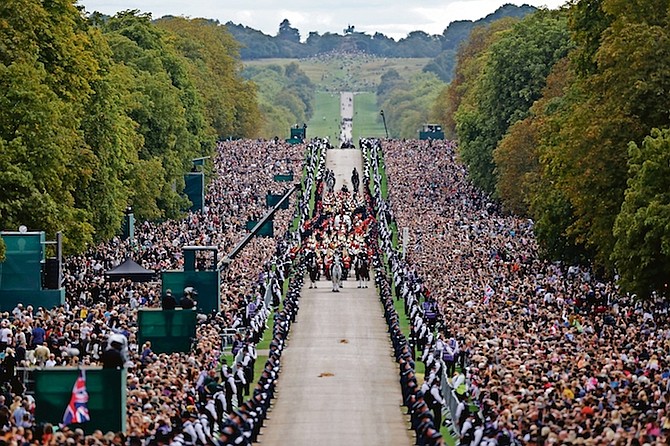THE HEARSE travels along the Long Walk as it makes its way to Windsor Castle, on the day of the state funeral and burial of Britain’s Queen Elizabeth, in Windsor. Photo: Carl Recine/AP
“Without memory, there is no culture. Without memory, there would be no civilisation, no society, no future.”
– Elie Wiesel, Holocaust Survivor
THE pomp, pageantry, mythology and history marking the period of mourning and state funeral of Queen Elizabeth II were fascinating to observe and moving on many levels, a sort of magical and solemn theatre with certain purpose.
Many rightly paid tribute to her extraordinary life, even those who are not monarchists, and including many who recognize the central role the British monarchy played in the imperial conquests and brutal colonisation by the United Kingdom.
But history is complex and multidimensional. The events surrounding the death and commemoration of the life of the late queen, telegraphed to billions and meticulously and brilliantly choreographed by the British state, were resplendent in meaning.
Observers, whether ordinary citizen or keen observer of such events, were taken by the depth of meaning, the plenitude of symbolism and the richness and reach of memory in the rituals of state for the passing of the Monarch.
It has been many years since most of the world has experienced such spectacular and elaborate ceremonial displays ranging from processions to the lying-in-state of Queen Elizabeth to her funeral, all of which were both exalted and simple. The funeral was viewed by 37.5 million people in the UK and four billion worldwide.
Her elegant funeral lasted approximately an hour. In The Bahamas, except for perhaps a few churches, an hour into a funeral is much nearer the beginning than the end of a final farewell.
The finest ceremonies recognise the proverbial “less is more”. Here at home, we often tend to jam-pack events with meaningless excess: too many songs, too many overblown speeches and tributes, and more for the sake of more.
Archbishop of Canterbury Justin Welby’s sermon at the late Queen’s funeral was less than ten minutes. He spoke of her long life but more importantly of Christian hope and the theology of the resurrection.
He was self-effacing, not self-referential and seeking to entertain as do some preachers in The Bahamas at church services and state events. He understood the moment, the rituals, the meaning of a Christian funeral, especially that of the Monarch.
When a religious minister, public servant or political leader does not understand the moment, the meaning of a ritual or history, their words and actions are typically empty, a sort of ersatz entertainment mostly displaying egoism and ignorance.
ESSENTIAL
The lying-in-state of the late Queen was an essential ritual in the passing of the Monarch. Thousands queued for approximately five miles and up to 24-hours along the south bank of the River Thames, in chilly weather in the evening, to view the Queen’s coffin and to pay her respect.
The coffin sat atop the raised catafalque in the grand Westminster Hall, below its 11th century medieval timber roof in the Palace of Westminster, which is at the heart of the British government. This signified the juxtaposition and constitutional relationship between monarch and parliament.
Her coffin was draped in the Royal standard, a banner with four quadrants, with representations of England, Northern Ireland and Scotland. Because it is constitutionally a principality, Wales is not featured.
Why would young and old, Britons from many walks of life, queue for many hours for less than a minute to view the Queen’s coffin? The queue became its own entity cum event, a living memorial of grief and gratitude: quiet, respectful, dignified, civil.
The queue was reminiscent of similar large-scale events, including that of the queues to view the coffins of Pope John Paul II and Nelson Mandela.
BYGONE ERA
Those on the queue in the UK recognised they were part of something grander than themselves, participants in an historic moment. The participants were likely also mourning a certain bygone era. Tellingly, the very same people who are likely the most ardent Brexiters are also likely the more ardent monarchists.
Still, those on the line and throughout the United Kingdom, paid respect to the Queen for her devotion to duty, service, life of sacrifice and unifying presence.
Civic rituals serve as history lessons, a renewal of shared citizenship and the inculcation of meaning for new generations. Countries must continually educate and inspire new generations. Memory and history are easily lost.
Even as the Queen’s passing was a unifying moment in many ways, the Britain she leaves behind is more diverse and divided than when she ascended the throne. It is quite possible that Scotland will become an independent country.
Still, a state funeral was not solely about the departed. It is equally about the nation-state, the collective, connected through a common shared experience designed to bind a people together and to create new memory.
A semiotic study of the events surrounding the Queen’s passing disclosed a treasury of signs and symbols about nationhood, British history, the monarchy and parliamentary government.
The commitment to continuity and change were writ large and in telling detail. The flowers on the Queen’s coffin were chosen by her son and successor, each flower signifying meaning, memory and continuity.
REMEMBRANCE
The rosemary represented remembrance, the sweet pea, a favorite of the monarch, was the flower of her month of birth. “The English oak symbolise[d] strength, a nod to the Queen’s constancy and steadfast duty.”
As reported in the UK, the myrtle on the late Monarch’s coffin, a symbol of a happy marriage, “was cut from a plant grown from a sprig of myrtle that was originally included in the Queen’s wedding bouquet in 1947”.
The British Monarchy, with its ancient traditions and contemporary necessities are imbued with a deep sense of the role of memory, vital for continuity and meaningful and necessary change.
Elie Wiesel, the late Nobel Prize winner, author and Holocaust survivor, wrote insistently of the necessity and role of memory. In his Nobel Prize address he explained: “Without memory, our existence would be barren and opaque, like a prison cell into which no light penetrates; like a tomb which rejects the living… For me, hope without memory is like memory without hope.”
Last week’s column discussed the importance of continuity. Here at home, how well do we ensure civic continuity and promote the preservation of memory in civic life and government?
CIVICS
Most Bahamians learn the pledge of allegiance and the national anthem, and are typically respectful during the playing of the latter. But we are woefully ignorant of basic civics.
This includes quite a number elected to parliament in various governments who are egregiously ignorant about our Constitution and the history of parliamentary democracy.
During our upcoming 50th anniversary of independence, the government may wish to create a number of engaging public education pieces on basic civics which can be replayed on social media, ZNS and the parliamentary channel.
It is disturbing how poorly we follow various protocols because of a certain persistent dysfunction and a lack of memory in the public service. For many years, it seemed as if we could not even get the Order of Precedence correct for public events.
Despite 50 years of independence, many public events often seem makeshift and incompetently organized as if we are conducting an event for the first time. Our political leaders have also sometimes caused harm to the sense of continuity.
We seem to play musical chairs with the appointment of the Governor General. The decision in 1992 for Sir Clifford Darling to go on vacation rather than have him read the Speech from the Throne was a mistake. It was not an act of political maturity.
Every time a new government comes to office, many expect a new Governor General to be appointed. We should try to avoid the perception that the occupant is a PLP or FNM head of state. Thankfully, none of them has been egregiously partisan in office.
Jamaica has been independent since 1962, 11 years earlier than The Bahamas, yet they have only had eight governors general, two of whom acted for short periods.
Sir Clifford Campbell served for ten years, Sir Florizel Glasspole for 17 years, Sir Howard Cooke for 14 years and Sir Kenneth Hall for three years. The incumbent, Sir Patrick Allen, who has served 13 years, has been in office for four administrations.
Since 1973, The Bahamas has had 11 Bahamian Governors General and will likely see the 12th fairly soon.
Dame Minita Gordon served as Governor General of Belize for 12 years and Sir Colville Young served for 27 years. Belize recently enacted legislation to limit the tenure of the head of state to seven years.
To allow for continuity The Bahamas should consider a tenure for the head of state for a minimum of perhaps seven years. Moreover, when we overly politicise various offices, such as that of Commissioner of Police, we lessen respect for institutions and roles.
The events surrounding the death of Queen Elizabeth remind us of the role of rituals, protocols and symbols in the promotion of meaning and memory, vital to sustaining and renewing our public institutions and form of government. Bahamian leaders and citizens might draw inspiration from the grand civics lessons we just witnessed.






Comments
Use the comment form below to begin a discussion about this content.
Sign in to comment
Or login with:
OpenID